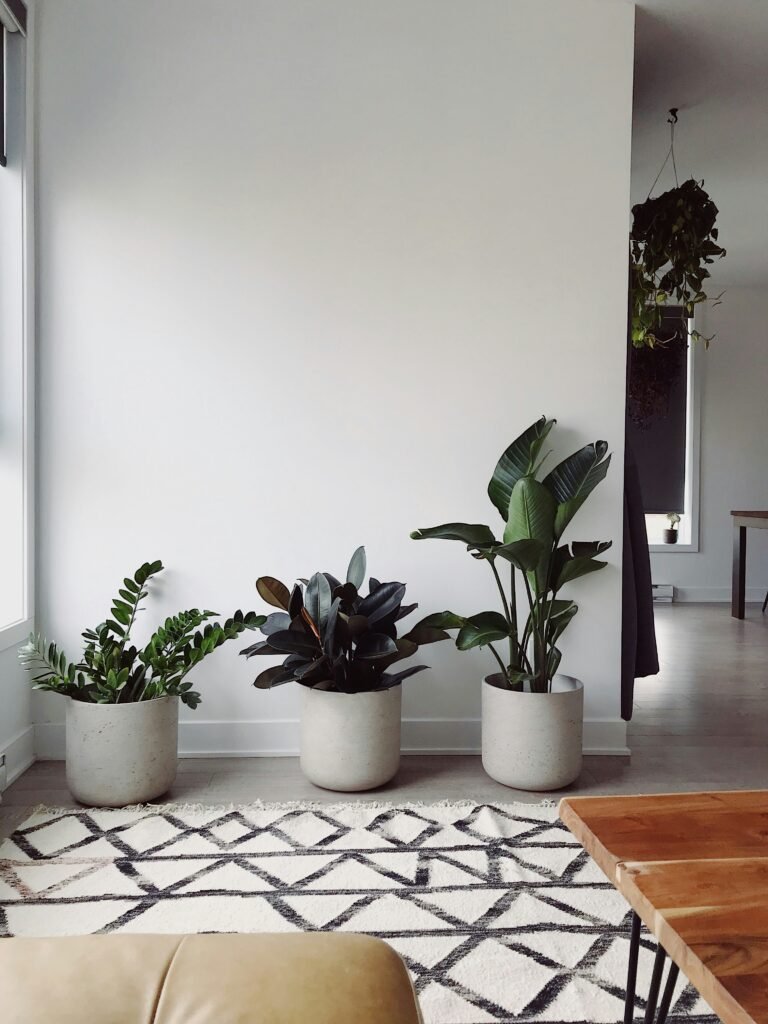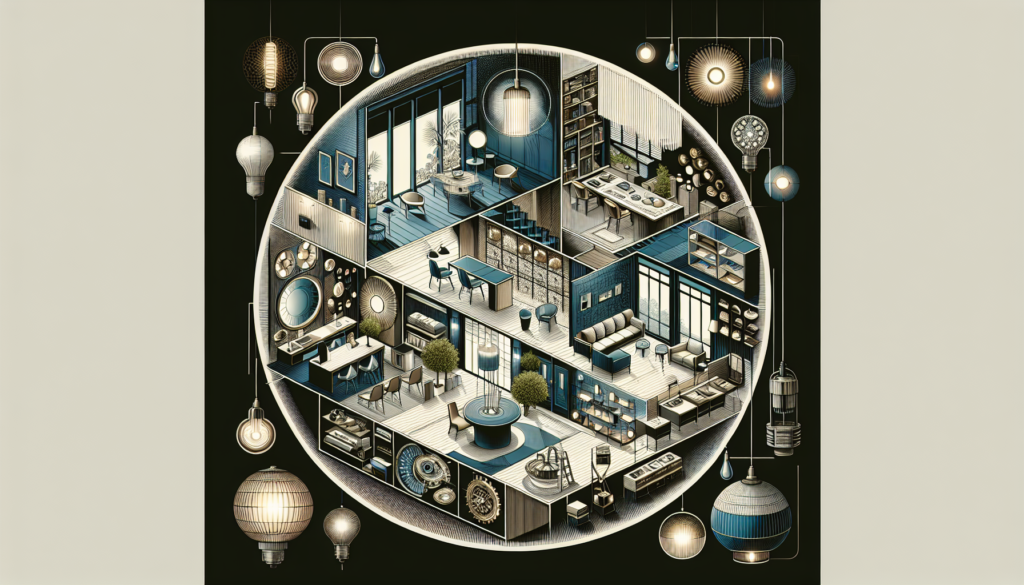Imagine stepping into a space that instantly takes your breath away. The stunning interior design captivates you, leaving a lasting impression. Have you ever wondered how lighting plays a crucial role in achieving such captivating designs? Lighting has the power to completely transform the mood, atmosphere, and overall aesthetic of any room. In this article, we will explore the importance of incorporating the right lighting techniques in interior design, unlocking the potential to create truly breathtaking spaces. Whether you’re looking to liven up your living room, enhance the ambiance of your bedroom, or revitalize your workspace, these lighting tips will guide you towards crafting a truly stunning interior design.

Understanding the Importance of Lighting in Interior Design
When it comes to interior design, lighting plays a crucial role in creating a space that is inviting, functional, and visually appealing. The way you choose to light a room can significantly impact the overall atmosphere and mood, as well as highlight the architectural features and artwork within the space. By understanding the importance of lighting, you can transform any room into a stunning masterpiece.
The Role of Lighting in Setting the Mood
One of the primary functions of lighting in interior design is setting the mood of a space. Lighting has the power to evoke emotions and create different atmospheres depending on the intensity, color, and placement of the light fixtures. Soft, warm lighting can create a cozy and intimate ambiance, perfect for bedrooms or living rooms. On the other hand, bright, cool lighting can invigorate and energize a space, making it ideal for kitchens or home offices. By carefully selecting the right lighting fixtures and dimming options, you can easily transform the mood of any room.
Enhancing the Visual Appeal of the Space
Another essential aspect of lighting in interior design is enhancing the visual appeal of the space. Lighting fixtures can act as decorative elements, adding a touch of elegance and style to any room. Whether it’s a stunning chandelier in the dining room or unique pendant lights in the kitchen, the right lighting fixtures can become a focal point and elevate the aesthetics of the entire space. Additionally, properly placed accent lights can spotlight architectural features, artwork, or other elements that you want to highlight in the room, creating a visually striking environment.
Creating a Functional and Practical Space
In addition to setting the mood and enhancing the visual appeal, lighting also serves a practical purpose in interior design. Proper illumination is essential for performing tasks efficiently and safely. Task lighting, such as under-cabinet lighting in the kitchen or reading lamps in the bedroom, helps provide focused and adequate light for specific activities. Ambient lighting, on the other hand, ensures an evenly illuminated space, allowing for easy navigation and reducing eye strain. By strategizing the placement and types of lighting fixtures, you can create a space that is both beautiful and functional.
Different Types of Lighting
To fully utilize the potential of lighting in interior design, it is important to understand the various types of lighting available and how they can be effectively utilized in different spaces.
Natural Lighting
Natural lighting refers to the illumination provided by natural sources, such as sunlight. It not only brightens up a room but also contributes to the overall well-being of the occupants. Maximizing natural light sources through the strategic placement of windows and skylights can help reduce the need for artificial lighting during the daytime, while promoting a connection to the outdoors.
General or Ambient Lighting
General or ambient lighting serves as the primary source of light in a room. It provides overall illumination and helps create a uniform brightness throughout the space. This type of lighting should be evenly distributed, using fixtures such as ceiling lights, chandeliers, or recessed lights. Ambient lighting sets the foundation for the room’s lighting scheme, creating a comfortable and inviting environment.
Task Lighting
Task lighting targets specific areas or tasks where focused illumination is required. Common examples include reading lamps, desk lamps, or under-cabinet lighting in the kitchen. Task lights should be strategically placed to minimize shadows and glare, ensuring optimal visibility and comfort for the tasks being performed.
Accent Lighting
Accent lighting is used to highlight specific features, artwork, or architectural elements in a room. It adds depth and visual interest by creating contrast. Accent lights can be directed towards a specific object or wall, drawing attention and creating a focal point. Examples of accent lighting include track lights, recessed spotlights, or wall sconces.
Choosing the Right Lighting Fixtures
Choosing the right lighting fixtures is crucial in achieving the desired atmosphere and functionality in a space. Here are some factors to consider when selecting lighting fixtures for your interior design:
Consider the Function and Purpose of the Space
Before choosing lighting fixtures, consider the function and purpose of the room. Each room has different lighting requirements depending on its intended use. For example, a living room may require a mix of ambient, accent, and task lighting to accommodate various activities such as entertaining guests, reading, or watching TV. Understanding the specific needs of the space will help you select the appropriate fixtures.
Matching the Style and Theme of the Interior
Lighting fixtures come in a wide range of designs and styles, from modern and minimalist to traditional and ornate. It is important to choose fixtures that complement the overall style and theme of the interior. The lighting should seamlessly integrate with the existing décor and contribute to the overall aesthetic appeal of the space. Consider the materials, finishes, and shapes of the fixtures to ensure harmony in the room.
Understanding Different Types of Light Bulbs
Aside from the fixtures, the type of light bulb used also plays a role in achieving the desired lighting effect. There are various types of light bulbs available, each with different characteristics. Incandescent bulbs produce warm, soft light but are less energy-efficient. LED bulbs are highly energy-efficient and have a longer lifespan, while also offering different color temperatures. Fluorescent bulbs are known for their cool and bright light. Consider the color rendering index (CRI) and color temperature of the bulbs to ensure they align with the desired ambiance and functionality of the space.
Considering Energy Efficiency
In today’s environmentally conscious world, energy efficiency is an important consideration when choosing lighting fixtures. Opt for energy-efficient LED bulbs and fixtures, which consume less energy and have a longer lifespan compared to traditional incandescent bulbs. Additionally, consider installing dimmers, which allow you to adjust the light output, saving energy and providing flexibility in creating various lighting effects.
Creating Layers of Light
To achieve a well-balanced and visually appealing lighting scheme, it is essential to create layers of light by combining different types of lighting.
Using a Combination of Different Lighting Types
Layering light involves using a combination of different lighting types, such as ambient, task, and accent lighting. By incorporating various sources of light, you can create depth and dimension in the room. For example, a living room can benefit from the warm glow of ambient lighting, complemented by a focused task light for reading and accent lighting to showcase artwork or architectural features.
Balancing Ambient, Task, and Accent Lighting
When creating layers of light, it is crucial to find the right balance between ambient, task, and accent lighting. Ambient lighting serves as the base layer, providing overall illumination to the room. Task lighting should be added to specific areas where focused light is needed, while accent lighting highlights key elements. The key is to ensure that each layer complements the others and works harmoniously to create the desired ambiance and functionality.
Utilizing Dimmers and Controls
Incorporating dimmers and lighting controls into your interior design allows for flexibility in adjusting the light levels and creating different moods. Dimmers help you customize the lighting to suit various activities or occasions, whether it’s a cozy evening at home or a festive gathering. Additionally, having separate controls for different zones or layers of light provides added convenience and allows for personalized lighting experiences.

Understanding Light Color and Temperature
Light color and temperature play a crucial role in setting the mood and ambiance of a space. Different color temperatures can evoke different emotions and create varying atmospheres.
Choosing the Right Color Temperature for the Space
Color temperature refers to the perceived warmth or coolness of a light source and is measured in Kelvin (K). Lower Kelvin values, such as 2700K to 3000K, produce warm, yellowish light, resembling the glow of a traditional incandescent bulb. Higher Kelvin values, such as 5000K to 6500K, produce cool, bluish light, resembling daylight. When selecting the color temperature for a space, consider the desired ambiance and functionality. Warmer temperatures are often used for creating cozy, intimate environments, while cooler temperatures are suitable for spaces that require bright, focused illumination.
Creating Warm and Cozy Spaces
Warmer color temperatures, ranging from 2700K to 3000K, can help create a warm and cozy atmosphere in the room. These temperatures mimic the soft, welcoming glow of candlelight or traditional incandescent bulbs. Warm light is often used in living rooms, bedrooms, or dining areas to promote relaxation, comfort, and intimacy.
Utilizing Cool Tones for a Refreshing Atmosphere
Cooler color temperatures, ranging from 5000K to 6500K, produce a crisp, white light that resembles daylight. This type of lighting creates a refreshing and invigorating atmosphere, making it ideal for spaces that require focus and productivity, such as kitchens, home offices, or bathrooms. Cool light can also help showcase colors and textures more accurately, making it suitable for displaying artwork or design features.
The Power of Natural Light
Natural light is a valuable asset in interior design, as it brings a sense of vitality and connection to the outdoors. Maximizing natural light sources can greatly enhance the overall aesthetics and functionality of a space.
Maximizing Natural Light Sources
To maximize natural light in a room, consider the orientation of the windows and the placement of furniture. Positioning furniture away from windows allows light to penetrate deeper into the space. Additionally, consider using light-colored window coverings that allow natural light to filter through while maintaining privacy.
Utilizing Window Treatments to Control Light
While natural light is desirable, sometimes it’s necessary to control the amount of light entering a room. Window treatments such as curtains, blinds, or shades offer flexibility in adjusting the intensity of natural light. You can choose translucent or sheer materials to diffuse light or opt for opaque materials for complete light blockage.
Enhancing Natural Light with Mirrors and Reflective Surfaces
To amplify the effects of natural light, incorporate mirrors and reflective surfaces into your interior design. Mirrors placed strategically opposite windows can reflect and bounce natural light deeper into the room, making it appear brighter and more spacious. Additionally, materials with reflective finishes, such as glossy tiles or metallic accents, can help disperse light and create a vibrant atmosphere.

Highlighting Architectural Features and Artwork
One of the purposes of lighting in interior design is to draw attention to architectural features, artwork, or other design elements that deserve recognition. By employing specific lighting techniques, you can effectively showcase these elements and create a visually stunning space.
Directing Attention with Spotlighting
Spotlighting involves using focused light to highlight a particular feature or object. It draws attention and creates a dramatic effect. Spotlights can be ceiling-mounted or recessed to illuminate architectural details such as columns, arches, or textured walls. They can also be used to highlight artwork, sculptures, or other decorative elements, acting as a visual focal point in the room.
Using Wall Washers for Dramatic Effects
Wall washers are fixtures that cast a wide, even beam of light along the wall, illuminating its entire surface. This type of lighting technique helps accentuate textures, colors, and finishes on the wall, creating a dynamic visual effect. Wall washers can be successfully used to highlight accent walls, textured wallpapers, or any other feature that you want to emphasize.
Displaying Artwork with Gallery Lighting
Artwork requires specific lighting to be showcased properly. Gallery lighting, also known as picture lighting, involves using focused lights or track lighting to illuminate artwork in a way that enhances its colors and textures. By carefully positioning the lights and adjusting the beam angle, you can effectively bring artwork to life, allowing it to become a captivating focal point in the room.
Creating a Focal Point with Lighting
Lighting fixtures themselves can act as focal points in a room, standing out as design elements and adding a touch of personality. By strategically selecting statement light fixtures, you can create a visually striking focal point that impresses and captivates.
Using Statement Light Fixtures
Statement light fixtures, such as chandeliers, pendant lights, or unique table lamps, can make a bold design statement in any room. These fixtures often feature intricate designs, interesting shapes, or luxurious materials that draw attention and become the centerpiece of the space. When integrating statement light fixtures, consider the scale of the room and the overall aesthetic, ensuring they complement the existing décor.
Drawing Attention with Pendant Lighting
Pendant lights are versatile fixtures that can be used in various settings to create a focal point. These hanging lights come in a wide range of styles, sizes, and materials, allowing for endless design possibilities. Use pendant lights above a kitchen island, dining table, or in a stairwell to draw attention and create a visually pleasing focal point.
Highlighting Art or Furniture with Direct Illumination
Another way to create a focal point with lighting is by directly illuminating a piece of artwork, a statement furniture piece, or an architectural feature. Use adjustable spotlights or track lighting to shine light directly on these elements, directing attention and adding depth to the room. Carefully consider the angle, intensity, and color temperature of the light to ensure it enhances the beauty of the focal point.

Considerations for Each Room
When it comes to lighting, each room in your home has specific requirements and considerations. By tailoring the lighting to suit the function and ambiance of each space, you can optimize the overall design and functionality.
Living Room Lighting
Living rooms are multifunctional spaces that can benefit from a variety of lighting types. Incorporate a mix of ambient, task, and accent lighting. Consider using floor lamps or table lamps to create cozy reading nooks, while also incorporating recessed lights or track lighting to highlight artwork or architectural features.
Bedroom Lighting
In the bedroom, lighting should promote relaxation and create a tranquil atmosphere. Use warm ambient lighting, such as bedside table lamps or wall sconces, to create a cozy ambiance. Dimmers can provide flexibility for adjusting the light levels, while task lighting on bedside tables or a standing lamp can provide focused illumination for nighttime reading.
Kitchen Lighting
Kitchens require different types of lighting to ensure functionality and safety. Ambient lighting can be achieved through recessed lights or ceiling-mounted fixtures. Under-cabinet lighting can provide task lighting for food preparation areas, while pendant lights above an island or dining table can create a visually appealing focal point.
Bathroom Lighting
Bathrooms require a combination of bright, functional lighting for grooming tasks and softer, more relaxing lighting for bathing. Use overhead lights or wall sconces to provide even illumination throughout the space. Incorporate task lighting near mirrors to eliminate shadows and ensure adequate visibility. Consider adding dimmers to adjust the lighting levels and create a spa-like ambiance.
Home Office Lighting
Home offices require lighting that promotes focus, productivity, and comfort. Natural light should be maximized whenever possible, as it helps reduce eyestrain and creates a refreshing atmosphere. Supplement natural light with task lighting, such as a desk lamp or adjustable floor lamp, to provide optimal illumination for work-related activities. Balance the lighting with ambient sources to create a well-lit space.
Outdoor Lighting
Outdoor lighting not only enhances the aesthetics of your home but also provides safety and security. Consider using wall-mounted fixtures or lanterns to provide general illumination for pathways, entryways, or outdoor seating areas. Install spotlights to highlight architectural details or landscaping elements. Use dimmers or motion-sensor lights for added convenience.
Lighting Mistakes to Avoid
While understanding the importance of lighting is essential, it is equally important to be aware of common lighting mistakes that can detract from the overall design. Here are some mistakes to avoid:
Insufficient Lighting
Insufficient lighting can make a room feel dark, cramped, and uninviting. Avoid using a single overhead light source as the sole lighting solution, as it can create harsh shadows and inadequate illumination. Instead, incorporate a mix of ambient, task, and accent lighting to provide a well-lit and visually appealing space.
Improper Placement of Fixtures
Improper placement of lighting fixtures can negatively impact the functionality and aesthetics of a room. Avoid placing task lights directly above the work area, as it can create unnecessary shadows. Consider the position of furniture and other elements when determining the placement of fixtures to ensure optimal illumination and avoid obstructing the view.
Neglecting Different Lighting Needs
Each room has different lighting needs based on its function and desired ambiance. Neglecting these needs can result in a space that is either too bright or too dim for its intended purpose. Consider the specific requirements of each room and implement appropriate lighting solutions accordingly.
Overlooking the Importance of Dimmers
Dimmers offer flexibility and control over the intensity of light in a room. They allow you to adjust the lighting levels to suit different activities or moods. Overlooking the importance of dimmers not only limits the versatility of your lighting scheme but also diminishes the overall ambiance that can be achieved.
Forgetting to Layer the Lighting
Layering light is crucial in creating a visually appealing and functional space. Forgetting to layer the lighting can result in a flat and uninteresting environment. Remember to incorporate a mix of ambient, task, and accent lighting to provide depth and dimension to the room.
Choosing Incompatible Light Bulbs
The type of light bulbs you choose can greatly impact the overall lighting effect. Choosing incompatible light bulbs in terms of color temperature or intensity can result in an unbalanced or discordant lighting scheme. Ensure that the bulbs you select align with the desired ambiance, functionality, and compatibility with the fixtures.
In conclusion, understanding the importance of lighting in interior design is essential for creating stunning and well-balanced spaces. By considering the role of lighting in setting the mood, enhancing the visual appeal, and creating a functional environment, you can transform any room into a truly beautiful and inviting space. By selecting the right lighting fixtures, creating layers of light, understanding light color and temperature, and utilizing the power of natural light, you can maximize the potential of lighting in your interior design. Additionally, by highlighting architectural features and artwork, creating focal points, and considering the specific lighting needs of each room, you can optimize the functionality and aesthetics of your space. Remember to avoid common lighting mistakes, such as insufficient lighting, improper fixture placement, neglecting lighting needs, overlooking dimmers, forgetting to layer the lighting, and choosing incompatible light bulbs. With these guidelines and considerations in mind, you can confidently design a well-lit and visually stunning interior that truly reflects your personal style and enhances your everyday living experience.



